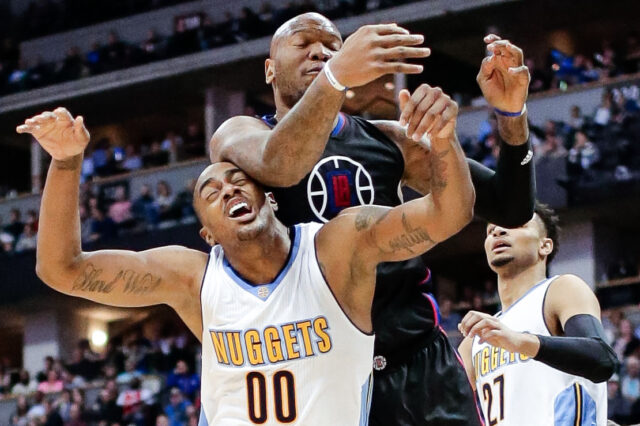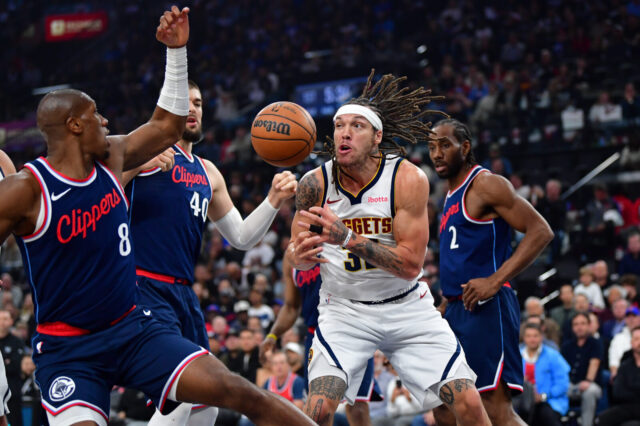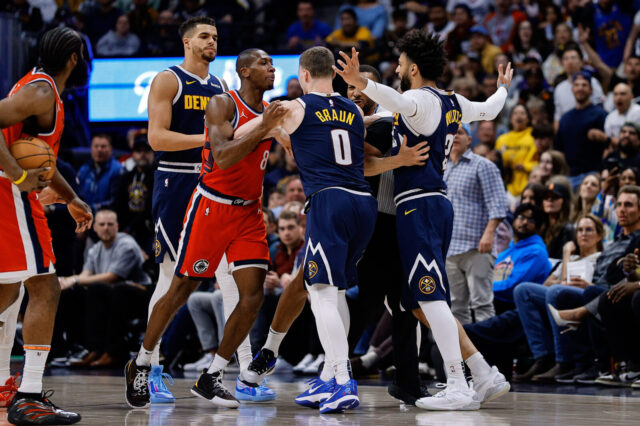First three PnRs
There were several moments in that first quarter where LeBron was able to move the Nuggets defense around the court like chess pieces before making his attack. He brought up Larry Nance Jr. for a pick and roll (PnR) three times in the opening minutes of the game and he got exactly what he wanted each time.
Denver allows a lot of spot up shots in the PnR, in part because of how hard and how late they rotate to tag the roll man and in part because they have a starting back court that lacks length to close out on shooters. In the three clips above, you can see how Gary Harris is ineffective at stopping both the roll man on the tag and closing out on the shooter when the ball gets skipped. This is one of the problem’s with Denver’s PnR defense. Too often, their effort to take away the paint and the rim results in taking away neither.
2nd three PnRs
After scoring on all three of the Nance-James PnRs, the Cavs switched things up a bit by running a second screen at LeBron. This adds a new wrinkle for the Nuggets by involving a third person into the on-ball portion of PnR defense. In the first example, you can see how much of a bind Harris is in trying to guess which person to cover, the rolling Nance Jr. or J.R. Smith spotting up on the wing. He does as good of a job as one can hope but LeBron is able to wait until the last second to make the pass to the wide open Smith.
In the second clip, Rodney Hood slips the second screen and spots up at the top of the key. Denver does a really nice job of rotating to close out on the shooters and breaks the play up. In the third clip, Harris should probably read the play a bit quicker. Hood sets the screen so early and so low that it becomes clear they are trying to get LeBron attacking the basket. A quicker read would place Harris stepping up to stop LeBron or take the charge.
Teams often run plays like this one in sets of three with three different main options. This is a good example of how the same (or very similar) play can emphasize three different looks depending on subtle changes like whether or not to slip a screen and where the screen occurs.
LeBron knows
I feel confident LeBron will be remembered for his once-in-a-generation combination of size and speed but to me what’s most impressive about him is his mind. He’s simultaneously one of the most physically dominant basketball players of all time while also being one of the smartest basketball players of all time. And while it doesn’t take a genius to figure out Denver’s PnR defensive habits, LeBron makes reading the defense into an art form. Just watch how he makes this skip pass without ever turning to look, making the turn and the pass in one motion. He knows before the play happens where Denver will be on the court.
Multiple efforts on defense
The clip below demonstrates just how hard it is to play defense in the NBA. Nikola Jokic does a really good job of showing on the PnR with active hands. He also does a decent job of rotating back to his man on the block and bumping off Jamal Murray who had come over to help. However, as Murray does a great job of running the spot up shooter off of the three-point line, Jokic is late to rotate over to force George Hill to pick up his dribble and 17 seconds of solid defense is wasted as LeBron gets the layup.
Mason Plumlee had a similar chain of plays in the game including this one where he does a phenomenal job of containing the ball, then shows incredible awareness to show on the shooter coming off of the screen until his man can recover, but he is late to show on the final drive as Trey Lyes gets beat with a head fake. In Jokic’s case, Murray did the right thing by running Hill off of the line. In Plumlee’s case, jumping at the head fake forces Plumlee to make a difficult rotation. Denver’s bigs are expected to be ready for such rotations but the perimeter players can help out by getting blown by slightly less frequently.
Double Hi, new wrinkle
Denver’s double high pick and pop play has been one of their go-to Lyles plays all year but against Cleveland, either by design or by reacting to the defense, Denver found a fun new wrinkle. The typical play has the two bigs set a double screen at the top of the key before Lyles fakes the roll and then pops behind a pindown screen from the other big. In this example, Lyles fakes the roll, then fakes the pop, then rolls for eal to the rim dragging both defenders with him. Jokic pops for the open three.
This is probably just two players reading the defense and calling an unofficial audible but whether it was by design or by accident, it offered a nice new look out of a worn-out set.
Fast 2nd screen
One of the things Jokic does so well is read when a situation calls for an immediate second screen. Here, Jokic receives the screen from Murray (an action the team has been doing a lot, lately) before flipping the ball to Murray and running an immediate PnR. That action forces Murray’s man to defend two screens in two seconds and provides just enough of a window for Murray to attack the basket.
Missed extra passes
One of the reasons the ball hasn’t been poppin as much as usual is because the team has missed a few golden opportunities to swing the ball around the horn. Here are two examples, one by Harris and the other by Paul Millsap.
Here is where my disagreement about the team needing to be more “aggressive” is really highlighted. In both examples, Harris and Millsap are just trying to be aggressive and attack the defense. In both cases, the smart play was to swing the ball. Few things break a team down like a drive, kick out, and swing around the three-point line forcing multiple rotations.
Bad shots that kill rhythm
Even more damaging than missed extra passes are the possessions like the one below without any passes at all.
Possessions like these seemed completely eliminated in the month of February but have returned with far too much frequency in the month of March. I have to think there is a correlation between the offense finding it’s rhythm and shots like this one which seem like a classic “I haven’t touched the ball in awhile so I’m going to try to get myself going” shot. Again, being aggressive isn’t difficult when the offense is flowing and the team is playing with trust. When the ball stops moving and the rhythm is killed, possessions like this become more common. And then the feedback loop begins. Shots like this kill rhythm even more and even more players feel the need to become “more aggressive.”


